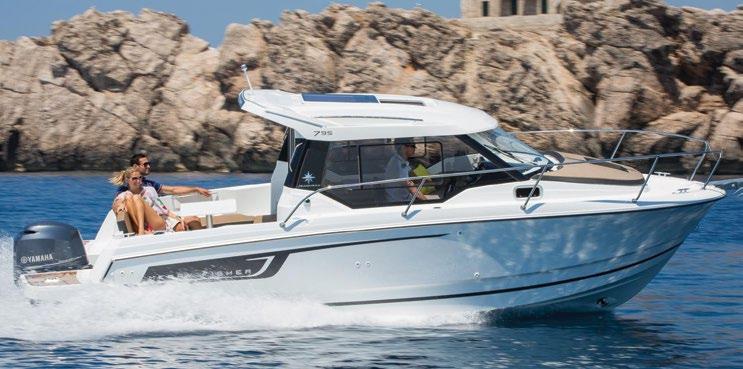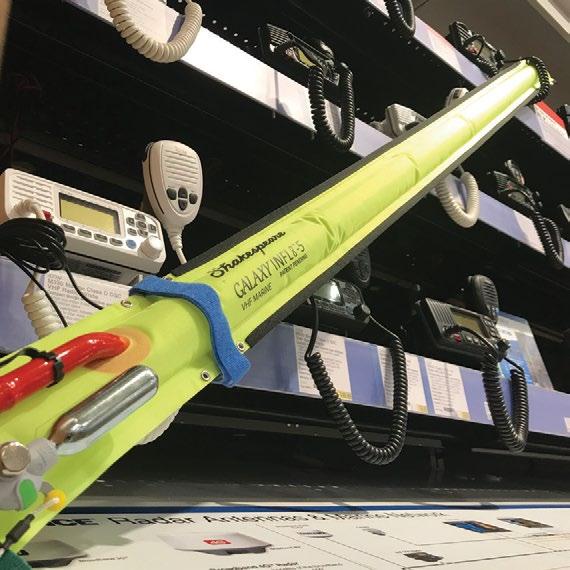
5 minute read
Don’t Hesitate to Renovate
you may see, they are distress lights. Secondly, they are approved for nighttime use only, which is why both come with a distress flag. This combination enables them to meet carriage requirements for day and nighttime emergency signals.
Although not Coast Guard-approved, one of the best all-around, nonpyrotechnic distress signaling devices is a signal mirror. Compact and simple to operate, signal mirrors have proven their worth in numerous rescues. In normal sunlight, flashes from a good signal mirror can be seen up to 50 miles away depending upon atmospheric conditions (the record distance during an at-sea rescue is 105 miles). They even work on bright overcast days and moonlit nights to an extent.
While there are reportedly cases where sailors have been rescued using the reflective holographic sticker on their credit card, don’t be tempted to rely on that or an old CD. Spend a little money and get the real thing.
Finally, distress signals won’t do you any good if you can’t find them in an emergency. Store them in a red or orange watertight container marked “Distress Signals” and keep it in a dry but readily accessible place. ★
CAPT. FRANK LANIER is an award-winning journalist, boat maintenance guru and owner of Capt F.K. Lanier & Associates, Marine Surveyors and Consultants:
CAPTFKLANIER.COM.
Now Dealer For:
Available Models:
NC 695, 795, 895, 1095 Standard & Sport Leader 7.5, 9.0, 10.5


NC 795
Perfect for enjoyable moments with family or friends, the 795 offers an open concept cockpit and U-shaped saloon to create a spacious and comfortable environment that truly enhances your boating lifestyle. Leader & NC Powerboats

Sailboats In-Stock
New Jeanneau 479 | 410 | 389 | 349
Looking to Sell? List With The Most Successful Brokerage Service On Lake Michigan
• More than 100 Boats Sold During the Last Year • Experienced Brokerage Professionals • Digital and Print Marketing
Boat Sales & Financing • Full Service Yard • On Site Ship’s Store Your Full Service Power & Sail Marina
Waukegan, IL (847) 336-5456 Milwaukee, WI (262) 498-2969 www.larsenmarine.com
New Safety Tech Advancements in technology ensure safe boating.
GLENN HAYES is a marine writer and photographer whose background in the marine industry and in marine electronics spans almost three decades and many thousands of miles at sea traveling the world. He can be reached at
HAYESSTUDIOS.COM .
While being on the water is all about having fun and enjoying your time afloat, it’s also prudent to be prepared for an emergency you hope never happens. Fortunately for today’s boater, there is an ever-increasing amount of safety equipment available that can turn a boating emergency from a tragedy into a great story for the grandkids.
Products like emergency position indicating radio beacons (EPIRBs) and emergency communication equipment have improved over the years and are more affordable and readily available to boaters.
McMurdo SmartFind G8 AIS EPIRB Recent changes in regulations for commercial vessels have created a new type of EPIRB that will facilitate faster, more precise rescues of vessels in distress, as well as creating better awareness of false activations. McMurdo has introduced its new SmartFind G8 AIS EPIRB, which is the first approved and available EPIRB in a new class that meets recently regulated SOLAS (Safety of Life at Sea) requirements that will go into effect July 2022.
This innovative EPIRB will not only work transmitting to the global system of COSPAS SARSAT satellites via 406MHZ, but will also work with GNSS networks, such as USA’s GPS, Europe’s Galileo, Russia’s GLONASS and China’s BeiDou Navigation Satellite System. By working with all of these systems, the SmartFind G8 is a truly global EPIRB that can lock in position through a range of navigation systems any time, anywhere globally.
What makes the EPIRB truly unique is its built-in Automatic Identification System (AIS). The SmartFind G8 will send out an emergency AIS signal that can be detected by nearby vessels equipped with AIS. The EPIRB will still send the emergency signal via satellite with coordinates of where the beacon is located. By also transmitting on AIS, nearby vessels within range will be aware instantly of the emergency and can respond accordingly. The transmission of this AIS distress signal can also allow for faster rescues due to an accurate acquisition of location by responders.
An added benefit of an EPIRB with AIS capability is better detection of false activations. If there is a false activation, those nearby vessels can

confirm that search and rescue is not needed and can free up this precious resource from a false call. These new EPIRBs are designed to result in faster and more accurate rescue responses. Previous classes of EPIRBs would transmit via satellite but would rely on the 121.5 homing signal to help rescue personnel narrow down their search, which could take longer to accomplish and wouldn’t happen until search and rescue arrived in the vicinity of the emergency.
Shakespeare INFL8-5 Inflatable VHF Antenna Another innovative safety product that has been introduced recently is Shakespeare’s INFL8-5 Inflatable VHF Antenna. While not as technologically advanced as the G8 EPIRB, its simplicity and ease of operation makes the antenna a no-brainer for anyone venturing out onto the water. While there are other emergency antennas on the market, this new inflatable model can outperform many of them.
Supplied in a bright, highly visible fabric pouch, the antenna can be instantly inflated via a CO2 cartridge to its full 5-foot length. It can also be inflated with a manual inflation valve similar to those found on inflatable life jackets. Once inflated, this new antenna can be attached to stays, towers, etc. via the attached hook and loop straps or grommets. If inflated with the CO2 cartridge, the antenna is even capable of being free standing.
With 3db of gain, this antenna can perform similarly to permanent antennas of a comparable size with the advantage of being attached anywhere. It comes with 20 feet of RG-174 cable attached and a PL259 connector. This connector will plug into most fixed-mount VHF radios. It’s also supplied with an SMA adapter cable that will allow it to connect to many handheld VHFs.
Because of its compact size when deflated, this new Galaxy INFL-8 antenna not only serves as an emergency antenna onboard but is also a good option for kayaks, small craft, dinghys, inflatables and jet skis. ★










